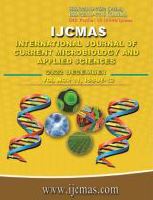


 National Academy of Agricultural Sciences (NAAS)
National Academy of Agricultural Sciences (NAAS)

|
PRINT ISSN : 2319-7692
Online ISSN : 2319-7706 Issues : 12 per year Publisher : Excellent Publishers Email : editorijcmas@gmail.com / submit@ijcmas.com Editor-in-chief: Dr.M.Prakash Index Copernicus ICV 2018: 95.39 NAAS RATING 2020: 5.38 |
Historical monuments and buildings represent an important part of the cultural legacy of past civilizations, in addition to being considered sites of endemic diversity, knowledge of this is essential, especially in photosynthetic organisms, since they are the pioneers in the establishment of those communities. Even though the morphological identification of photosynthetic microorganisms represents a challenge due to the phenotypic plasticity they present, so the use of Molecular Biology techniques is essential. The objective of this work was to identify species of microalgae and cyanobacteria present in three archaeological zones: Malinalco and Teotihuacán of the State of Mexico and Yohualichan, of the State of Puebla, through the partial amplification of the genes that code for the 16S rRNA and 18S rRNA subunits by the PCR technique using 2 pairs of primers and the sequencing of the amplified ones. In this way, 3 of the 10 strains isolated at the species level were identified: Chlorella sorokiniana, Chlorococcum vacuolatum and Klebsormidium crenulatum, and the other just at genus level because some initiators did not provide enough information. In this way, the use of morphological and molecular characters contributes to a more complete and reliable taxonomic identification.
 |
 |
 |
 |
 |